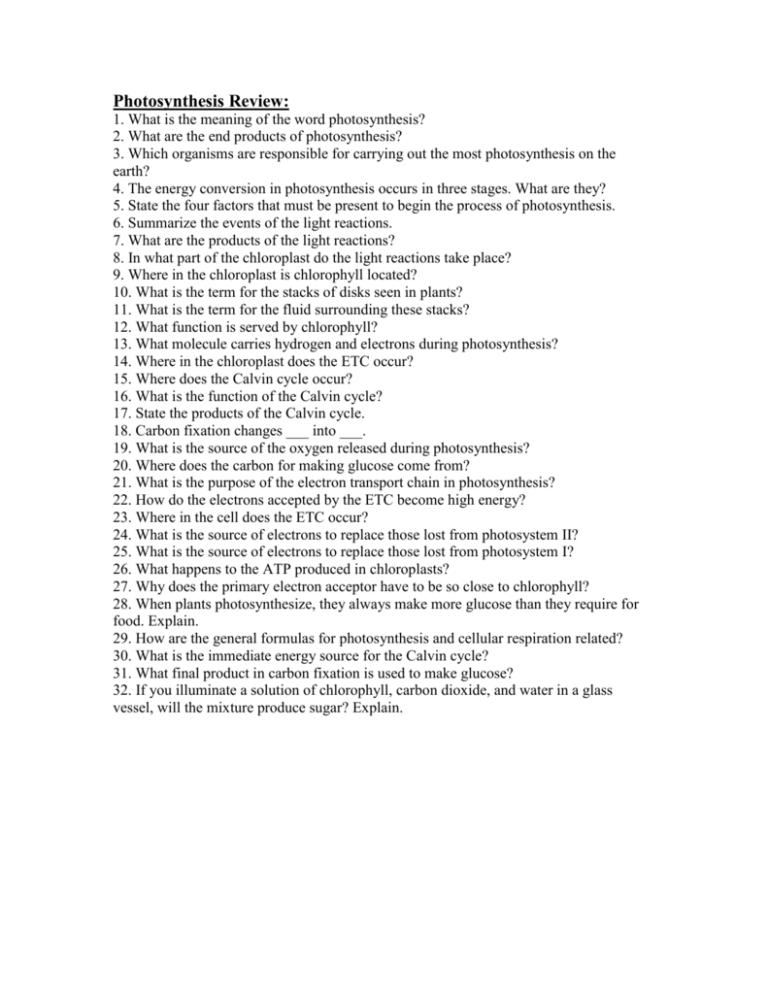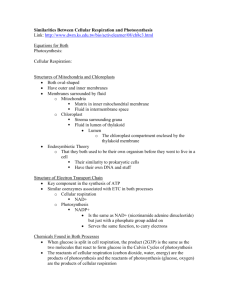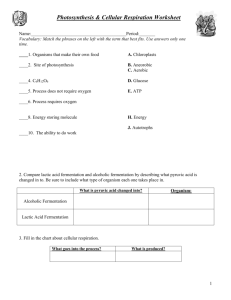Photosynthesis Review:
advertisement

Photosynthesis Review: 1. What is the meaning of the word photosynthesis? 2. What are the end products of photosynthesis? 3. Which organisms are responsible for carrying out the most photosynthesis on the earth? 4. The energy conversion in photosynthesis occurs in three stages. What are they? 5. State the four factors that must be present to begin the process of photosynthesis. 6. Summarize the events of the light reactions. 7. What are the products of the light reactions? 8. In what part of the chloroplast do the light reactions take place? 9. Where in the chloroplast is chlorophyll located? 10. What is the term for the stacks of disks seen in plants? 11. What is the term for the fluid surrounding these stacks? 12. What function is served by chlorophyll? 13. What molecule carries hydrogen and electrons during photosynthesis? 14. Where in the chloroplast does the ETC occur? 15. Where does the Calvin cycle occur? 16. What is the function of the Calvin cycle? 17. State the products of the Calvin cycle. 18. Carbon fixation changes ___ into ___. 19. What is the source of the oxygen released during photosynthesis? 20. Where does the carbon for making glucose come from? 21. What is the purpose of the electron transport chain in photosynthesis? 22. How do the electrons accepted by the ETC become high energy? 23. Where in the cell does the ETC occur? 24. What is the source of electrons to replace those lost from photosystem II? 25. What is the source of electrons to replace those lost from photosystem I? 26. What happens to the ATP produced in chloroplasts? 27. Why does the primary electron acceptor have to be so close to chlorophyll? 28. When plants photosynthesize, they always make more glucose than they require for food. Explain. 29. How are the general formulas for photosynthesis and cellular respiration related? 30. What is the immediate energy source for the Calvin cycle? 31. What final product in carbon fixation is used to make glucose? 32. If you illuminate a solution of chlorophyll, carbon dioxide, and water in a glass vessel, will the mixture produce sugar? Explain. Cellular Respiration Review: 1. What two molecules are formed when a phosphate is removed from ATP? 2. Describe how photosynthesis and cellular respiration are reverse processes. 3. What is the function of ATP? Describe the molecule. 4. Describe how ADP is converted into ATP. 5. Differentiate between oxidation and reduction reactions. 6. Why is an electron transport system important to living organisms? 7. Why are oxidation reactions often associated with the production of ATP? 8. In the reaction ADP + P forms ATP is energy stored or released? 9. Compare and contrast ATP production in anaerobic versus aerobic environments. 10. The primary source of energy for the cell is (a) starch (b) cellulose (c) glucose (d) ATP (e) sunlight 11. Compare and contrast alcoholic fermentation, lactic acid fermentation, and glycolysis. 12. Why must glycolysis occur before the steps of aerobic respiration can begin? 13. What is the purpose of the phosphorylation of glucose in glycolysis? 14. As glucose is broken down into pyruvate, the hydrogen atoms and their electrons are picked up by (a) NAD (b) NAD+ (c) NADP+ (d) NADP 15. Explain how the Krebs cycle contributes to the production of ATP. 16. Explain how energy is released in useful packets through the ETC. 17. What molecule carries the hydrogen and electrons removed from glucose? 18. When do animal cells perform photosynthesis? 19. When do plant cells perform photosynthesis? 20. When do animal cells perform cellular respiration? 21. When do plant cells perform cellular respiration? 22. The removal of carbon dioxide from pyruvate distinguishes fermentation from lactic acid anaerobic respiration. What would occur if an enzyme in your body removed the carbon dioxide from pyruvic acid before lactic acid formed? 23. Under what conditions does lactic acid fermentation occur in muscles? How can we tell that the fermentation is occurring? 24. Complete the chart below: Anaerobic Respiration Aerobic Respiration net amount of ATP produced terminal electron acceptor location in cell final products 25. What kind of fermentation do yeasts perform? 26. What are the waste products of yeast fermentation? 27. Provide an explanation for the fact that the maximum alcohol concentration in wine is usually no more than 12-14%. 28. If yeast cells were large organisms, they could not live anaerobically. Explain. 29. What are the waste products of cellular respiration? 30. Where in the cell does the ETC occur? 31. Describe the role of NADH in cells. 32. What happens to the NADH produced by yeast cells that are living in anaerobic conditions? 33. Identify the use of each of the reactants in cellular respiration and the source of each of the products.









